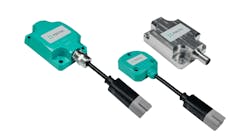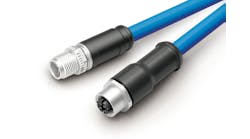A new twist on thermal printers enables labeling and marking possibilities
Controls engineers have a lot on their plates. With new safety guidelines, we are faced with a lot of potential for additional risk. Accurate documentation is a key to success. Competitive markets mean we have to produce a product that stands out from the crowd. One of the first places that a potential client will look is under the hood of our new beast. The electrical panel and associated wiring can make or break a design.
Wire and terminal labeling has come a long way from the days of pre-printed strips of numbers. The evolution of marking has transitioned through the white and clear write-on labels to systems that allowed you to design them on a computer and print them out on a dot-matrix printer. Remember those? Later developments brought us handheld labelers that print on roll stock. Gone are the dot matrix, and now printers give us fine fonts and very readable text. The clearest of these utilizes thermal transfer technology.
Thermal transfer is an existing technology that has been around for years. We compile a list of wire tags, export them to spreadsheet or database and then import them into a label maker of some sort. The label maker prints on roll stock and we have a string of labels spit out, ready to apply to our wires. Pick your favorite wire supplier or terminal block manufacturer, and they would be happy to sell you a wire labeler.
Many labeling companies have augmented their product lines to include a variety of roll widths and a broad spectrum of media materials including polyester, polyimide, polyolefin, vinyl, metalized films and even cloth. You can print out labels that mimic the traditional lamacoid labels for 22-mm and 30-mm push-button operators. Label makers can print out peel-and-stick labels that are as long as your imagination. These are great for marking up processing pipes.
Staying on the traditional theme, the control panels of yesterday were detailed with the addition of snap-in labels for terminal blocks. These labels were produced by loading a sheet into a tabletop x-y plotter and using some interface software to plan out the printing of labels. The x-y systems were tedious to work with and led to plenty of frustration with all the management of pens and ink cartridges. These high-maintenance systems tended to push users back into pre-printed labels, rather than go through the fuss and muss.
While this might work for a while, the automation environment places great importance on keeping machines running, and a stock label that needs a set of prints to help to decipher the circuits just isn’t as attractive as it once was. We need a way to create informative labels that are customized to suit our designs.
A new twist on the thermal printing market is a mix of old and new. Some creative manufacturers are combining the customization features of an x-y plotting system with the convenience of a portable label printer. The result is a thermal transfer printer that accepts label templates as well as large format label media to allow for completely customized labels. Stellar 300 x 600 dpi-resolution graphics with the convenience of solid ink ribbon eliminates any issues with clogging pens and dried up ink. This new technology opens up a world of possibilities when it comes to marking and labeling. Multiple film colors and ink ribbons bring the visual factory to life. The number of combinations is really up to the imagination of the user.
Traditional methods of marking up a machine involved specialty etching equipment to remove layers of plastic from a lamination and then applying the result to the machine with adhesive or rivets or both. With custom-print-and-apply technology, a designer could draw up a diagram in a CAD system and then download it to the printer for creating one-of-a-kind labels. How about custom labels for pneumatic devices? Imagine your machine with individual labels for each adjustment point. It’s thermal transfer printing with pretty much infinite font selection. Clear, concise and easy to read. There are thousands of graphical symbols in the open domain, and any of these can be incorporated into a label with these newer systems.
Technological advances open up a whole world of potential applications. Start with a pre-printed label or design one of your own. Imagine the flexibility of making your own enclosure labels. The design of a system in the marketplace is a dynamic entity. Technology moves along so fast that a change of direction can happen right in the middle of a project. Print-on-the-go means you don’t have to plan the panel labels weeks in advance and then go through the stress of having to get some redone when there is a change in design. Want labels that aren’t generic? Design them as you need them. Want your company logo on the label? Add one. How about custom operation labels? Nothing dresses up a machine like a customized label that, for example, shows the user how to thread the film through the rollers.
ALSO READ: Don't let poor wire and cable decisions slow down your next project
Printers are now designed with flexibility in mind. Let’s face it, we all have our favorite brand of wire and terminal markers. Why buy a printer that only prints one brand of label or marker strip? Manufacturers are providing templates that work with a variety of brands to give a single source for your marking needs. This technology is just emerging, but it won’t be long before more marking companies jump on the bandwagon. With advances like this, it just isn’t acceptable to write on a label with a pen and expect your client to be happy with the results. It will be interesting to see where this goes in the next year or so.
At the same time, it isn't acceptable to create labels that cannot stand the test of time. Machines and process skids are designed to last a decade or more. The labels and the related printing must outlast the machine. Fading ink, worn-out graphics and peeling labels are real possibilities in industrial environments. The labels are part of the control system design, so design appropriately, or your documentation will be lost.
Rick Rice is a controls engineer at Crest Foods, a dry-foods manufacturing and packaging company in Ashton, Illinois. With nearly 30 years’ experience in the field of automation, Rice has designed and programmed everything from automotive assembly, robots, palletizing and depalletizing equipment, conveyors and forming machines for the plastics industry but most of his career has focused on OEM in the packaging machinery industry with a focus on R&D for custom applications. Contact him at [email protected].






